I had a bit of time to spare before the Molly Dancing began outside the Cutter Inn on Saturday, so why not do a little exploring?
My wandering footsteps soon rewarded me with this view of the magnificent Cathedral soaring above the other buildings. Unsurprisingly the Cathedral is a Grade I Listed Building, but perhaps a little less obviously the red telephone box in the foreground is also listed. And quite right too; it's one of the icons of England and was designed by Giles Gilbert Scott. Interestingly a lot of the nineteenth-century work to preserve the Cathedral was overseen by Giles's grandfather, Sir George Gilbert Scott.
However, a building being listed does not guarantee that lots of work will be undertaken to preserve it, or that anyone will go and look at it, or indeed that anyone cares. I was making my way through the streets of Ely to seek out something that 99.9% of visitors never see.
Ely has plenty of historic listed buildings, 197 of them in all, and 191 of those are within the central square mile. Most of them are domestic dwellings, but there are also many important buildings which are part of the Cathedral complex - oh, and that telephone box!
As I walked along I noticed this old wall. It's patched and battered appearance tells of a long and interesting history. It may surprise you to learn that this is a Listed Building too. It's the first sign that we are entering a small area that is rich with history.
Here a former gate or door has been blocked up using large, square-cut building stone. Now the Isle of Ely has many wonderful things but, being composed of clays and gravels, it doesn't have any good quality stone. These have clearly been brought here from elsewhere, not to block up and old gateway, but as part of a building which has been demolished. And an important building at that.
Peering over a gate and between the high hedges you can just see a building known as St John's Farmhouse. Although it's been converted into a farmhouse you can clearly see an infilled arch which looks like part of a religious building. The Ordnance Survey map shows, in its fancy Gothic print with which it denotes historic sites, "Hospitals remains of".
The Knights Of St John seem to be a curious lot, dividing their time between fighting crusades and building hospitals, which gives them their other name, the Knights Hospitaller. These two aims came about from both protecting pilgrims on their way to Jerusalem and tending for any who were sick or injured. And that's what we have here - the remains of two hospitals, St Mary's and St John's, which were united in the year 1240.
Just around the corner you'll find this building which, although it seems to be used as a barn today, is actually the former St John's Chapel. St John's Farmhouse, that we saw earlier, is believed to be part of the Chapel of St Mary. Presumably, in the absence of medical knowledge, the monks who ran the hospitals did a lot of praying for the souls of those they tried to care for.
In the mid-sixteenth century Henry VIII seized all the lands of the Knights Hospitaller along with every monastic foundation in the land, even though he had no use for the buildings and many fell into ruins, or, as here, were repurposed as agricultural buildings. You can clearly see the lancet windows of the chapel, albeit that they've been rather crudely bricked up. The door beneath has a much more workaday look to it.
This door, on the other hand, is obviously part of the old chapel. Both buildings, the farmhouse and the barn, as well as two other buildings on the site which can't be seen from the road, are listed as Grade I, because of their age and historical importance. And if you look carefully there's a strangely carved stone above that door arch.
Here's a close-up of it. It's rather weathered but experts who have examined it reckon that it shows a man sitting astride an ox and blowing some kind of horn. To me it looks as though he's sitting on the ox backwards which makes it even stranger. No one has any idea of the significance of the carving, but it's thought by some to date from as long ago as the eighth century. Worth going a few steps out of your way to see.
Take care.


























































